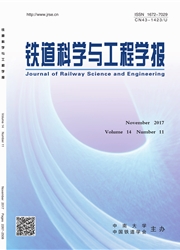

 中文摘要:
中文摘要:
为考察西安—平凉铁路桥梁上钢-混凝土组合桁架节点的受力性能,进行2个耳板式节点的小比例尺模型试验。介绍了节点的试验方法和结果,描述了整个加载过程的节点行为,讨论了节点的受力性能、承载力和破坏模式。试验结果显示节点的失效模式可能有混凝土开裂破坏、内置钢筋屈服和腹杆屈曲。应用有限元软件对试件进行全过程数值模拟分析,计算结果和试验结果吻合良好,有限元分析结果表明:节点的薄弱部位主要位于腹杆,通过增加腹杆厚度可增强节点强度和刚度,有效提高节点的承载能力。研究成果可以为此工程和同类工程节点设计提供理论依据和试验参考。
 英文摘要:
英文摘要:
The behavior of steel-concrete composite truss joints in the Xi'an-Pingliang Railway Bridge is experimentally researched.Two joints of ear plate at small scale were tested under horizontal linear loading.In the paper,the test method and results and the behavior within the whole loading period were reported,and the joint behaviour,the load carrying capacity and the failure mode were discussed.The experimental results show that the failure mechanisms include the cracking of concrete,the yielding of internal steel,the buckling of local steel.With finite element analysis of the specimen,the results coincide well with the experimental results and show the joint's weaknesses are the braces.It is proved that increasing the thickness of abdominal could enhance both strength and stiffness of the joint and improve the capacity.The results provide a theoretical reference and basis for the design of joint in this project and similar ones.
 同期刊论文项目
同期刊论文项目
 同项目期刊论文
同项目期刊论文
 期刊信息
期刊信息
